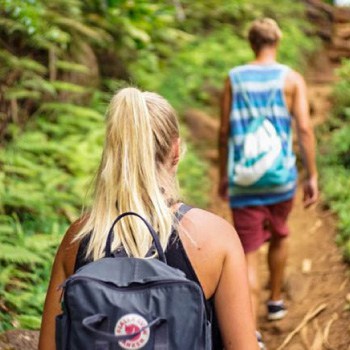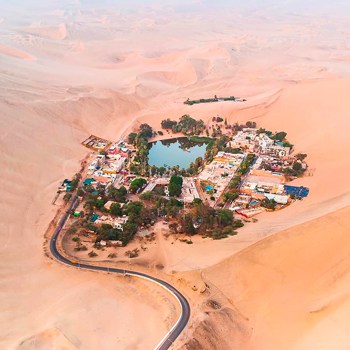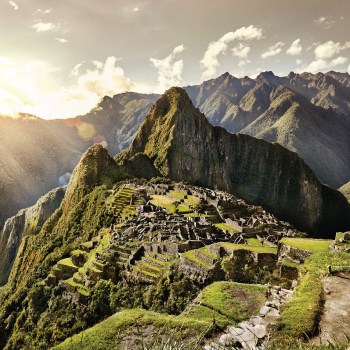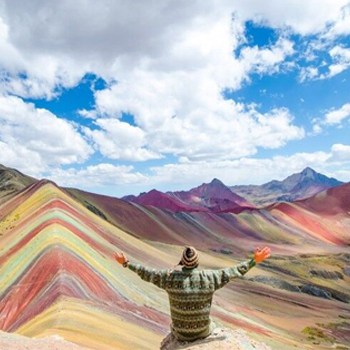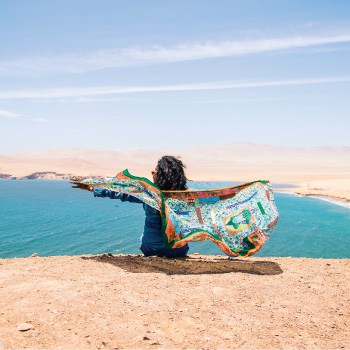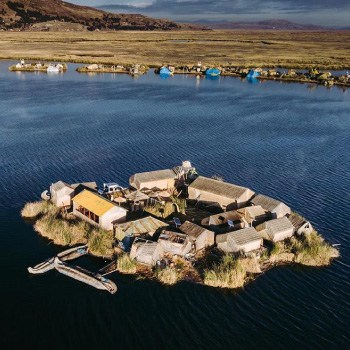Peru Bolivia Border Crossing Nightmare
Peru Bolivia Border Cross: 2024 updated information on crossing the Peru Bolivia border, what to expect and what you need to do to prepare ahead of time.
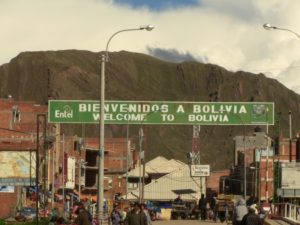
Crossing the Peru Bolivia border:
It had been a long 27 hours on the bus which had barely any stops. There were 1 or 2 stops towards the later hours of the journey (the last 7-8 hours out of the 27 hours overall) due to people being dropped off in the various towns along the way to the Peru Bolivia border. Thankfully, we decided to stock up on water and snacks before we got on the bus in Lima which was the only thing that stopped us from starving throughout the journey.
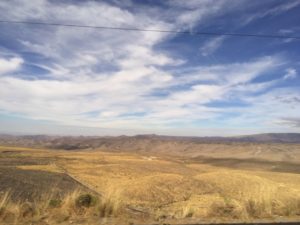
We started our trip from Lima and needed to get to La Paz as quickly as possible because we had overstayed our tourist visas in Peru. Flying was out of the question as the cheapest flights we could find were around $350-400 U.S. dollars. Every day we waited, the fine built up. Although the fine is only U.S. $1 dollar for every day you overstay, this adds up to be such an unnecessary expense when you overstay by around 40 days. When we got to the border, although we knew we had to pay our fine, we had no idea what was coming our way.
We started off by getting off the bus in Desaguadero which is one of the border towns between Peru and Bolivia. It had been a while since we had a proper meal so once we found where to cross the border, we decided to have some lunch because we weren’t too sure if we would have another opportunity for a decent meal before arriving in La Paz, a 2-and-a-half-hour taxi journey from Desaguadero. We got a nice meal of roast chicken and chips for 12 soles ($3.50-4 dollars) and were ready to get in the queue for the border. We took Civa Bus from Lima and throughout the journey weren’t given any information about crossing the border. We had no idea if we needed anything for the cross and expected customs to be similar as to what you would find in the airport. My friends and I knew that Americans needed a special visa and had to pay an additional fee for entry into Bolivia, but that there was no need for us to apply for a visa to cross the border as Irish citizens.
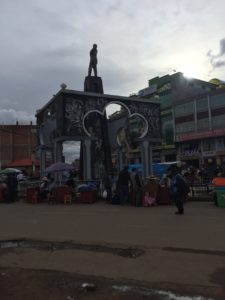
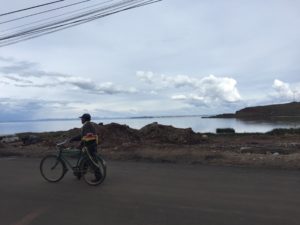
The queue for the border was pretty long at around 4-4:30 pm. As we waited our turn in the queue that stretched out the door of the border office all the way up the road, we noticed that some people had paper forms that they were filling out. While 3 of us waited in line, one of the guys went to have a look around to see if he could find anything. He came back a few minutes later with a sheet for each of us, telling us we needed to fill them out to be able to cross the border. As we slowly moved up the line filling out our border paperwork, about 30 minutes of waiting later we got to the top of the line. We handed up our passports along with the newly filled out sheets of paper and waited. Assuming the fine would be just paid there and then, we took out our money roughly estimating how much it was going to cost us.
Communicating with the workers at the border can be difficult as they don’t really speak English. Luckily, one of our friends travelling with us was a half Peruvian, half American guy, fluent in Spanish living in Peru. We met him while travelling in Peru and had made plans to go to Bolivia for 7-10 days at New Years. He was the only reason things went as smoothly as they did, and things didn’t go very smoothly…
ENTERTAINMENT TIP: If looking for fun at night, or to watch sports during the day, or even a taste of home, visit the Wild Rover Hostels Chain for great food, sports and beer! Entrance to their bars is free even for non-guests
As the man working at the border started typing on his computer and checking the details of my passport and paperwork, he started talking to me in Spanish. I was trying to pick up on the few words that I knew when all of a sudden he picked up the paperwork I had filled out for the border and ripped it up in my face before throwing it in the bin. I might not have understood his Spanish, but I certainly knew this couldn’t be good. I called over Danny, our American-Peruvian Spanish speaking friend and asked him to translate. Eventually, we got handed a piece of paper with the amount for the fine written on it along with instructions telling us we needed to go to a certain bank to pay the fine, and then come back with a separate form printed off the internet. As the time was starting to get late, we decided we could worry about the printed out sheet later from the couple of internet cafes around and that we needed to get to the bank. The bank that we were required to go to (the only bank where the visa fine can be paid) was not in a convenient location in relation to the border office. After asking 6 people and walking 25 minutes, we finally got to there.
We got very lucky here because as soon as we walked in, they locked the doors behind us and wouldn’t allow anyone else in. The 4 of us commented on how lucky we were because if we didn’t make to the bank on time, we would have had to spend the night in the border town of Desaguadero, where there really isn’t a whole lot going on. Waiting for over an hour and a half in the bank, we were starting to get tired. After a 27-hour bus journey, we queued for 30 minutes in line at the border, walked 25 minutes to the bank and queued for almost 2 hours in the bank. We finally paid the fine and walked back to the office with smiles on our faces thinking the border crossing journey was almost over.
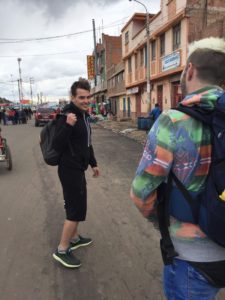
We remembered being told about the sheets we were suppose to pring out before returning to the border, but weren’t exactly sure what the required sheets were. We decided that going back to the border to ask was the best option. We had agreed that we would get a small taxi (tuc-tuc style ones with motorbikes) back to border office to save a bit of time and effort but of course, there were none to be found when needed. We walked 20-25 minutes back to the Peru Bolivia border office and skipped the queue to ask our quick question about the paperwork. By we, I mean Danny, who had to be our liaison the whole day. Without him, we would have been lost. He coordinated pretty much everything from finding where the bank was to how to pay the fine to exactly what paperwork we needed. It must have been such an inconvenience for him as he got his visa in less than a minute with his Peruvian I.D., but lucky for us, he was happy to help. Once we found out exactly what paperwork we needed to print, we found out that we needed around 8 photocopies each in total, of different things. Once again leaving the border office, we looked for the closest internet café to sort everything out once and for all. After searching online for about 10 minutes we found the government website we needed to print our sheets from. Going from the internet café to the photocopy place next door, we hoped we were able to remember the right combination of passport pages, visa sheet and proof of fine paid to be photocopied. Once complete, we paid and thanked the man at the photocopy store and once again cheerfully went back to the border office to queue, hoping this would be our final time there. It was now around 8:30 pm now and the queue into the office was still surprisingly quite long. After about 20 minutes we were at the top of the line just waiting for something to go wrong once again. For the first time the entire day, things went okay and we finally got our stamps to cross the Peru Bolivia border.
Walking across the bridge which was the border, we joked and laughed about the experience thinking that we had finally made it into Bolivia, and all that there was left to do was get to La Paz. What we didn’t realise though, was that all of that trouble so far had been just to get our exit stamps out of Peru. Now, we had to get our Bolivia entrance stamps. We found the start of the queue for customs, where we would need to get our stamps for entry and nearly broke down. The line snaked around 3 times in the building before stretching out the door for 40 metres. We knew we were going to need to queue for at least another hour to an hour and a half before getting the stamp. At this point, we actually couldn’t do anything but laugh it off. There was no point in getting upset, angry or frustrated about the situation as it wouldn’t change anything. It was actually really surprising to see how we all dealt with the situation so well because although it doesn’t seem that bad while reading back over everything, it was an absolute nightmare at the time.
We picked up the Bolivian border forms (which you can only get by showing your passport to one of the guards at the entrance, due to different countries needing different forms/visas for entry), got in the queue and started filling out the sheets of paper in the dark as the lights in the building where you queued were broken. Luckily, this time there were no curve balls apart from the waiting and we eventually got through. It took a little over an hour to get from the start of the queue to reach the end. Finally, for the 4th or 5th time that day, we once again left the office with smiles on our faces, laughing and joking about the experience saying it was finally over and that we were so ready to make our way to La Paz to party. By this point, we should have just known that things weren’t going to go our way, but being as naive as we are, we were optimistic anyway.
It was around 10 pm and we now had to now find a way to get to La Paz. Talking to some nice locals in the bank earlier on in the day, we were told that getting a taxi wouldn’t be too expensive even though it was a 2 and a half hour journey, and it would be much faster than a combi/colectivo. We were happy to pay the extra, especially at the time because there weren’t a lot of combis around. Talking to a couple of taxi drivers, the cheapest quote we could get was 200 Bolivianos more expensive than what we were told to expect. Thinking that the drivers were trying to rip us off because they were the first group of taxi’s we went up to, we told them no thanks and continued walking around for a little bit to look for another taxi. Having no luck, we even tried going into a hostel and ask the reception to call us one. Getting quoted around the same price from a couple of different drivers, we said that we would just pay the cost because we really just wanted to get out of there. In the end, by the time we found a taxi that would take us, the only price they would go for was 100 Bolivianos more expensive than what the initial drivers had said. We had a little chat amongst the 4 of us and decided to go for it because we couldn’t take it any longer. After 5-6 hours of trying to cross the border and a rip off taxi journey later, we were finally on route to La Paz.
Although we should have done a little bit more research about crossing the Peru Bolivia border, the only thing that could have gone different was that we would have had the sheets needed for printing and photocopying prior to our visit to the Peruvian border office. We ended up having a great time in Bolivia and although as much as I wish I could say this was the extent of the problems we faced throughout the trip, it turned out to be only half of it, as crossing back over the Peru Bolivia border turned out to be disastrous as well.
Crossing the Bolivia Peru Border
We booked our return to Lima with a Civa bus from Puno at 3:30 pm thinking that getting to Puno wouldn’t be too difficult. We went to the travel agency in our hostel the day before leaving to ask them about the fastest way to get to Puno. The man working at the agency told us that we could book a bus from the bus station in Bolivia that would take us all the way to Puno arriving at around 1:30 pm. We bought our tickets and got ready to leave the next morning thinking we had everything organised. Not surprisingly, once again, we were wrong…
The bus we got on the next morning wasn’t the nicest but because it was only supposed to be a 5-hour journey to Puno it wasn’t a big deal. The ticket for this 5-hour journey from La Paz cost us 120 Bolivianos per person. As we travelled, just talking and enjoying the scenery, around 4 and a half hours passed before we arrived in Copacabana, where we would be crossing the border. The journey from Copacabana to Puno is a 2-3 hour one and we arrived in Copacabana late, at 1 pm. Knowing our bus was at 3:30 pm, we started stressing as we had to make it to Puno on time and still hadn’t crossed the border.
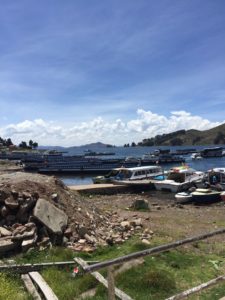
Everyone got off the bus in Copacabana (after crossing the lake) and was told to take their luggage with them. Confused, we asked the driver if the bus would be continuing to Puno as we were told it would be in La Paz. The bus driver said that the bus wouldn’t be departing until 3 o’clock, which was way too late for us. We made the quick decision that we would have to pay out extra for a taxi to be as quick as possible. Getting to the border office in Copacabana was a 20-minute taxi ride from where we got dropped off by the bus. By luck, we had the exact amount of Bolivianos left on us needed for the taxi to the border office from Copacabana, between all of us combined for the taxi journey, 20 Bolivianos. We got to the border office and got our exit stamp from Bolivia pretty quickly. As soon as we got to the stamp, we rushed over to the Peruvian side, into the customs office and started filling out our entrance sheets. Although we spent over 6 months in Peru before going to Bolivia, we had plans of extended stay upon re-entry and were trying to get another 183-day visa. Once our forms were filled out, we went up with our passports and asked for an extended travel visa with a smile on our faces. The man working behind the glass took my passport and started typing on his computer. Once again, communicating wasn’t the easiest as the people working had barely any English. Danny, who at this point was used to acting as our translator, didn’t even need to be asked to come over as he could see a problem arising. The man working at the border told Danny that there was no chance we would be getting a longer visa, especially after overstaying the first time around. After trying to reason with the worker, we finally managed to get a 10-day visa after which we were told we would need to leave the country.
We walked out of the border office pretty defeated and worried about what we were going to do. When we got out of the office, we saw a big green bus with ‘BOLIVIA HOP’ written across the side. There was a group of passengers standing around and we started talking with them telling them what had just happened to us. A couple of the passengers were telling us that they were in the same situation with overstaying their visas and were also looking for the extended 183-day visa upon re-arrival. The only difference was that they were able to get theirs without any hassle! Being in complete shock about what they just said, we questioned how they managed to get the visa, wrongly assuming they must have bribed the border workers. To our surprise, they told us that they only had to talk with their guide on the Bolivia Hop bus and explain their situation. All Bolivia Hop passengers get border crossing assistance both upon exit and entrance to Peru and Bolivia, as the guides hand out the necessary paperwork on the bus and help passengers fill them out before arrival. Then, once at the border the guide assists people with talking to the border workers as they don’t have any English and helps people get back through.
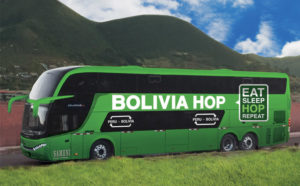
We had read and heard about the border crossing assistance you receive with Bolivia Hop before we booked our trip from Lima to La Paz and thought that this was just a marketing tactic used by the company to try and get more passengers. After hearing the different stories about how smooth and comfortable everyone’s journey was from Peru to Bolivia and vice versa, we immediately regretted not travelling with them. They were able to get across the border so easily and make it to their various destinations in both of the countries quickly.
Unfortunately, because we still had a bus to catch we didn’t have time to stand around talking all day. While saying goodbye to the passengers we were talking, we started to look for a taxi. All the trouble we had been through while crossing the borders both times just started rushing through my mind. All that hassle; waiting, printing, photocopying, more waiting, paying extra for buses and taxis, had been for nothing. If only we had travelled with Bolivia Hop, this whole nightmare could have been avoided and we could have saved ourselves a good bit of money. Getting a taxi from the border to Puno cost us another 200 soles and we had no choice but to pay it if we wanted to make it in time for our bus back to Lima.
Sitting in the taxi, we were jealous thinking about the people who got their extended visas upon re-entry to Peru. At this point of the journey, we had overpaid over by nearly 650 soles (~$215 U.S. dollars) between the two borders for just the additional taxis we were told we wouldn’t need, and the bus which left us stranded after arriving in Copacabana late. We sat in the taxi for 2 hours rushing to make it to Puno on time, trying to think about what we were going to do with the short 10-day Peruvian visa we had just received. The one thing I could not stop thinking about was the fact that if we travelled with Bolivia Hop we would have been on a nice comfortable bus the entire journey, with our brand new 183 day visas, not having to pay so many unexpected, expensive fees and enjoying ourselves a whole lot more.
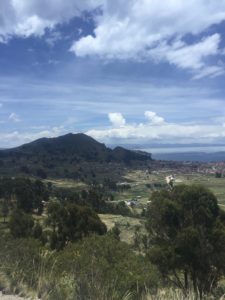
At this point the only thing left to go wrong was for us to miss our bus from Puno but luckily, thanks to Peru being an hour behind Bolivia, we made it on time. It was then a 24-hour bus journey back to Lima, again with barely any stops. We picked up some water and snacks at the bus station which once again was the only thing that kept us from starving on the journey.
As I write this on the long and uncomfortable bus journey back to Lima, we still have to figure out our plan for what we’re going to do about the shortened visa. If there’s anything I’ve learned from the whole experience and would recommend as advice, it is to travel with Bolivia Hop, whether you’ve overstayed your visa or still have time on it. T
By travelling with them, you know there’s not going to be any hidden costs or worry about having to make it to a certain place on time. The fact that we didn’t get our extended visas wasn’t the only thing that was a problem because even if that wasn’t an issue, there were all the hidden taxi and bus costs, along with the printing and photocopying costs. Not to forget the cost of nearly having to spend a night in Desaguadero, if we got to the bank 5 minutes later. Looking back, we should have done a little bit more research before booking or organising anything. The whole experience was a complete nightmare and I could not have been happier it was over.
If you still decide not to travel with Peru / Bolivia Hop, I would recommend you to get yourself a Danny, as it would have been impossible for us without someone fluent in Spanish.
All in all, these are the combined stats from crossing both borders:
- Direct journey with Civa from Lima to Desaguadero: 27 hours and 160 soles($55 dollars) per person.
- Total time spent at border before taxi to La Paz along with costs: 6 hours of walking all over the town and 120 soles per person for the fine with printing and internet cafe costs coming to around 15 soles per person
- Time and cost it took to get a taxi to La Paz: 2 and a half hours and 300 Bolivianos (150 soles/$50 dollars)
- Morning bus from La Paz to Copacabana (which was supposed to be Puno, but completely off schedule and wrong): 5 hours to Copacabana and 120 bolivianos per ticket (60 soles/$20 dollars)
- Taxi from Copacabana to border: 15-20 minutes and 20 bolivianos (10 soles/$4 dollars)
- From Bolivia border office to Peru border office: 10 minute walk
- From Peru border office to Puno by taxi: 2 and a half hours and 200 soles ($65 dollars)
- Direct bus from Puno back to Lima with Civa: 24 hours and 120 soles ($40 dollars) per person
I hope that none of you encounter any of the problems we did at the border and were able to get a laugh from our misfortune and learn from our mistakes. Best of luck on your travels and enjoy crossing the border!
